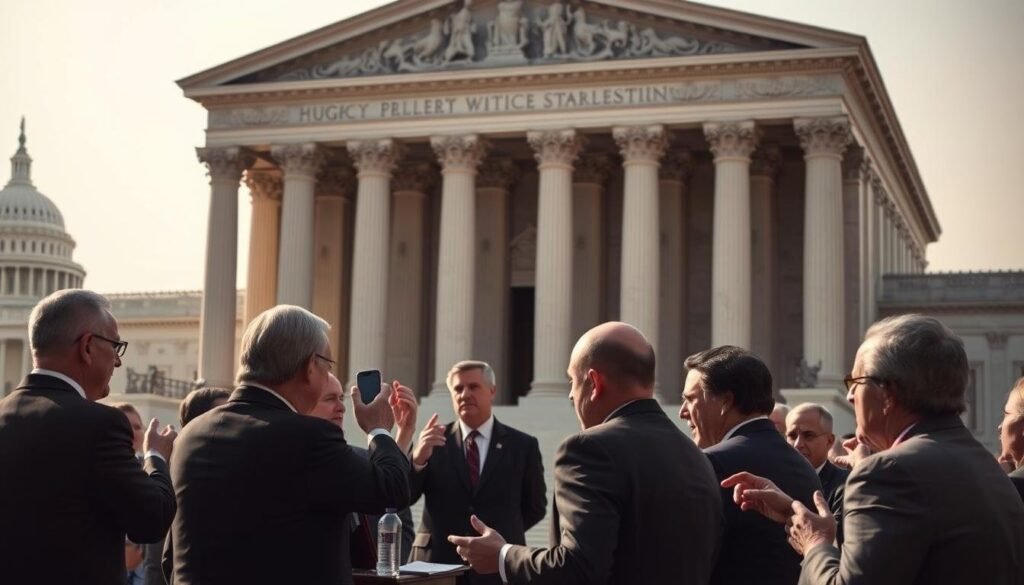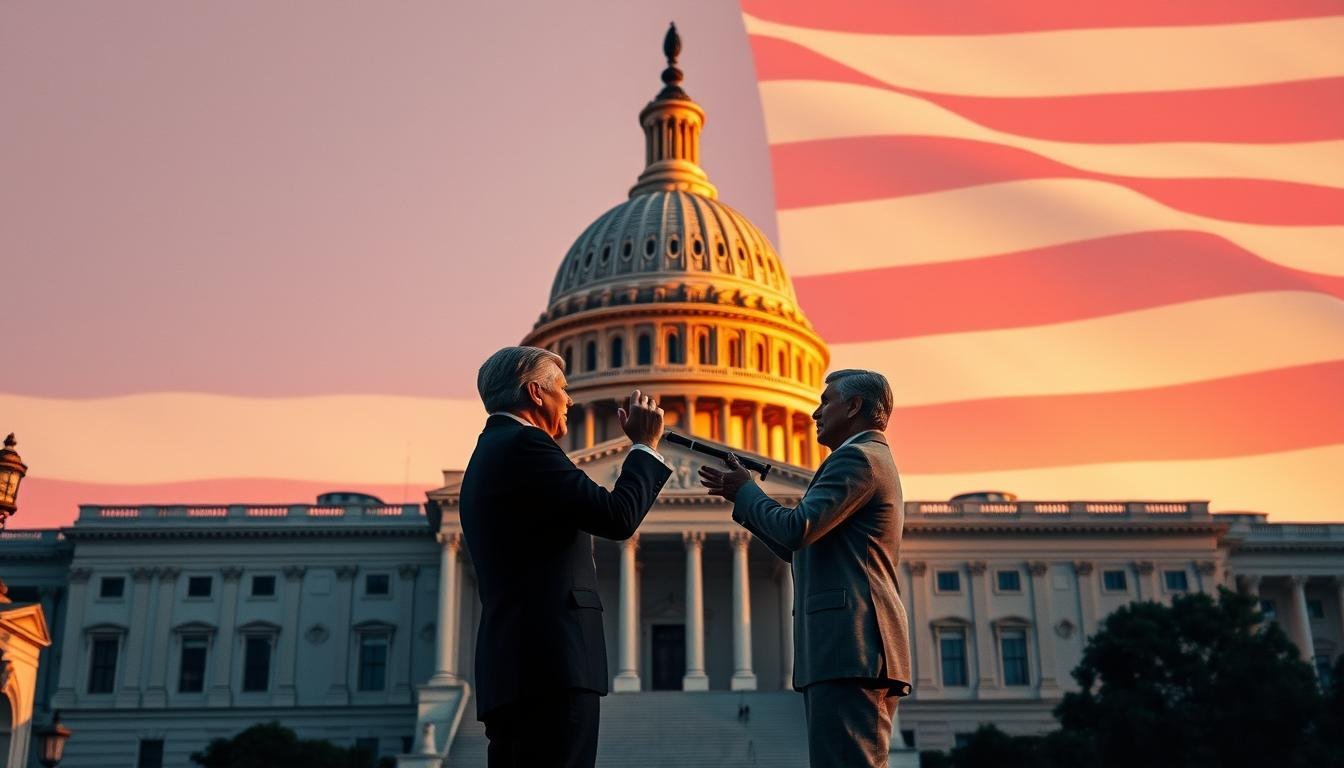Can the President Declare War Without Congress? You’re about to dive into a complex topic in the United States: the power to declare war. The constitutional framework says Congress can declare war. But it also gives the President a lot of power as Commander-in-Chief.
As you explore this topic, it’s key to know the history and laws behind the President’s power to start military actions. The War Powers Resolution of 1973 is a key law. It tries to share war-making power between the President and Congress.
You’ll learn about the details of this debate. You’ll see how laws, practical issues, and history affect the President’s power to go to war without Congress. [Can the President Declare War Without Congress?]
Contents
- 1 Constitutional Framework of War Powers
- 2 Can the President Declare War Without Congress?
- 3 The War Powers Resolution of 1973
- 4 Modern Examples and Legal Interpretations
- 5 Conclusion: Can the President Declare War Without Congress?
- 6 FAQ
- 6.1 What is the constitutional framework for declaring war in the United States?
- 6.2 How can Congress influence military action through funding?
- 6.3 What is the War Powers Resolution of 1973?
- 6.4 Can the President declare war without Congress under the War Powers Resolution?
- 6.5 What are National Security Directives, and how do they relate to presidential war powers?
- 6.6 How have Authorizations for Use of Military Force (AUMFs) been used in modern times?
- 6.7 What are the different legal interpretations of presidential war powers?
- 6.8 How do drone strikes and covert operations factor into the debate over presidential war powers?
- 6.9 What is the significance of the 60-90 day timeline in the War Powers Resolution?
- 6.10 How does the Constitution’s division of war powers impact the balance between the executive and legislative branches?
Constitutional Framework of War Powers
It’s key to understand the balance between presidential authority and congressional oversight in war powers. The U.S. Constitution splits these powers between Congress and the President. Congress can declare war, while the President is the Commander-in-Chief.
This setup is meant to keep power in check. It ensures no one branch has too much control over military actions. You’ll see how this works, especially with Congress’s role in funding and its past limits on military operations.
Funding as a Check on Military Action
Congress’s power to approve or deny military funding is a big check on presidential authority. By controlling the money, Congress can shape military actions. For example, funding for specific operations can come with conditions, letting Congress guide the President’s strategy.
| Mechanism | Description | Impact on Military Action |
|---|---|---|
| Appropriation of Funds | Congress approves or denies funding for military operations | Directly affects the ability to conduct military operations |
| Conditional Funding | Congress sets conditions on the use of appropriated funds | Influences the scope and strategy of military engagements |
Historical Examples of Congress Limiting Military Operations
Congress has stepped in to limit military actions before. For instance, in the Vietnam War, Congress passed the Cooper-Church Amendment in 1970. It aimed to restrict U.S. military actions in Cambodia. These examples show Congress’s power to counter presidential authority through laws.
Can the President Declare War Without Congress?
The President’s role in declaring war is a topic of debate. The Constitution gives Congress this power, but the President has significant authority as Commander-in-Chief. This creates a complex situation about the President’s power in emergencies.
The President can start military action quickly to respond to threats. National security directives help the President make fast decisions to protect the country.
National Security Directives
National security directives are important for the President. They outline policies and actions for the country’s security. The President can use them to start military operations, impose sanctions, or take other necessary steps.
| Directive Type | Purpose | Example |
|---|---|---|
| Military Operations | Authorize military action | Operation Enduring Freedom |
| Sanctions | Impose economic penalties | Sanctions on Iran |
| Cybersecurity | Enhance cybersecurity measures | Executive Order on Cybersecurity |
Immediate Response to Threats
The President often acts fast to respond to threats. This is because time is critical in protecting national interests. [Can the President Declare War Without Congress?]
The balance between the President’s power and Congress’s oversight is delicate. The President has a lot of power as Commander-in-Chief, but Congress can declare war and approve military spending. This balance is key to ensuring military actions are effective and answerable to the people.
In summary, the President’s power to declare war without Congress is shaped by the need for quick action and national security directives. Understanding these aspects is crucial for understanding war powers in the U.S.
The War Powers Resolution of 1973
The War Powers Resolution of 1973 was a big step by Congress to limit the president’s power to start wars without approval. It came after the Vietnam War raised big questions about the president’s authority.
This law has two main parts. They are about the president telling Congress about military actions and the time limits for these actions. [Can the President Declare War Without Congress?]
Presidential Reporting to Congress
The law says the president must tell Congress within 48 hours if troops are sent to fight. This rule helps Congress keep an eye on the president’s actions.
The 60-90 Day Timeline
The law also says troops must leave within 60 days unless Congress says it’s okay to stay longer. If the president needs more time, Congress can agree to a 30-day extension. This balance helps ensure the president can act quickly but also needs Congress’s approval for long wars.
Here’s a quick summary of the War Powers Resolution:
| Provision | Description | Timeframe |
|---|---|---|
| Presidential Reporting | Mandatory report to Congress on military deployment | Within 48 hours |
| Withdrawal of Troops | Troops must be withdrawn unless Congress authorizes an extension | 60 days (with a possible 30-day extension) |

In conclusion, the War Powers Resolution of 1973 is a key law that has changed how the U.S. handles war powers. It shows how the president and Congress work together during conflicts. Understanding its rules helps us see the importance of checks and balances in government.
See Also: Who Was the President During 9/11?
Modern Examples and Legal Interpretations
The world is changing fast, and so is the debate on presidential power in military actions. Different views on the law are now more visible than ever. [Can the President Declare War Without Congress?]
Authorizations for Use of Military Force (AUMF) play a big role in today’s wars. An AUMF lets the president use military force against certain targets or in specific situations.
Authorization for Use of Military Force (AUMF)
AUMFs have been used for many military actions. They range from the 2001 authorization after 9/11 to recent ones against terrorist groups.
- The 2001 AUMF has been seen as allowing ongoing fights against al-Qaeda and its allies.
- New AUMFs have focused on groups like ISIS.
This shows how the president and Congress work together but also have disagreements. The president often wants broad interpretations of these laws.
Drone Strikes and Covert Operations
Drone strikes and secret operations have raised big questions about who should decide on military actions. These actions often happen outside of traditional war zones.
For example, killing terrorist leaders has been done often. This has led to debates on the legal reasons behind such actions.
| Aspect | Expansive View | Restrictive View |
|---|---|---|
| Legal Basis | Executive authority as Commander-in-Chief | Requires specific congressional authorization |
| Oversight | Limited congressional oversight | Robust congressional oversight |
Those who think the president has a lot of power say it’s because of the Constitution. They believe the president can act quickly in emergencies.
This view is important in today’s fast-changing world. [Can the President Declare War Without Congress?]
Restrictive View Favoring Congressional Oversight
Others believe the Constitution gives Congress more power over war. They say Congress should have a big say in military actions.
This view thinks Congress should approve big military actions. It ensures the decision to go to war is not just the president’s.
In conclusion, the debate on presidential war powers is ongoing. It’s shaped by current events and legal views. The balance between the president and Congress is key to American democracy.
Conclusion: Can the President Declare War Without Congress?
The debate on war powers in the U.S. is shaped by the Constitution and the War Powers Resolution. The President and Congress’s relationship is key to this issue. It makes sure national security threats are handled while keeping democracy strong.
The balance between the President’s power and Congress’s oversight is vital. This balance keeps American democracy strong. Looking at different views and examples shows how important it is for the U.S. to face national security challenges well.
Understanding war powers and their role in U.S. politics is crucial. The Constitution sets the stage for war powers, while national security needs quick and effective action. This balance is essential for the U.S. to protect its interests.
See Also: How Did President Hoover React to the Bonus Army?
FAQ
What is the constitutional framework for declaring war in the United States?
The Constitution gives Congress the power to declare war. The President is the Commander-in-Chief. This creates a balance between the legislative and executive branches.
How can Congress influence military action through funding?
Congress can control military actions by deciding on funding. They can limit or approve funds, shaping the scope and length of military operations. [Can the President Declare War Without Congress?]
What is the War Powers Resolution of 1973?
The War Powers Resolution of 1973 is a law. It aims to balance the President’s power with congressional oversight. It requires the President to report and withdraw troops within 60-90 days.
Can the President declare war without Congress under the War Powers Resolution?
The War Powers Resolution lets the President take action without a formal declaration. But, the President must notify Congress and actions are limited in time.
What are National Security Directives, and how do they relate to presidential war powers?
National Security Directives are documents from the President. They outline national security policies and strategies, including military actions. They guide decision-making in the executive branch.
How have Authorizations for Use of Military Force (AUMFs) been used in modern times?
AUMFs have been used for specific military actions, like against terrorist groups. They are debated for their scope and how long they last. [Can the President Declare War Without Congress?]
What are the different legal interpretations of presidential war powers?
There are two main views on presidential war powers. Some believe the President has wide authority. Others think Congress should have more oversight and limits on the President.
How do drone strikes and covert operations factor into the debate over presidential war powers?
Drone strikes and covert operations raise questions about presidential authority. They often involve military action without Congress’s approval or public knowledge.
What is the significance of the 60-90 day timeline in the War Powers Resolution?
The 60-90 day timeline is key in the War Powers Resolution. It requires the President to withdraw troops or get Congress’s approval for continued action. It’s a check on the President’s power.
How does the Constitution’s division of war powers impact the balance between the executive and legislative branches?
The Constitution’s division of war powers ensures a balance. It prevents either the President or Congress from having too much power. This creates a system of checks and balances.

Hi, I am Tatum Bradford from Washington. I have a background in political science and work as a senior revenue officer. I love learning about U.S. presidents and sharing interesting facts about political history.

